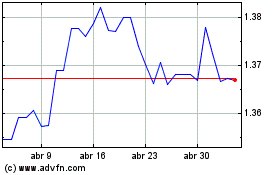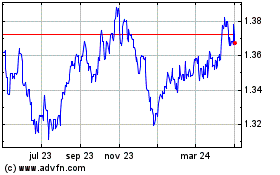Canadian Dollar Falls As Oil Prices Drop On Inventory Data
03 Octubre 2019 - 4:04AM
RTTF2
The Canadian dollar declined against its major counterparts in
the European session on Thursday on falling oil prices, as bearish
inventory data added to investor worries about slowing fuel
demand.
Crude for November delivery fell $0.16 to $52.48 per barrel.
Data from the Energy Information Administration showed Wednesday
that U.S. oil inventories increased by 3.1 million barrels in the
week ended September 27, nearly twice the expected jump.
The EIA report also said gasoline inventories for the week fell
by about 230,000 barrels, much less than the expected drop.
Meanwhile, distillate stockpiles dropped by about 2.4 million
barrels, nearly 25% more than what was forecast.
Data from payroll processor ADP showed that U.S. private sector
employment rose slightly less than expected in September. Weak data
raised concerns about an economic slowdown, hurting energy
demand.
Official jobs data is due on Friday.
U.S. employment is expected to increase by 140,000 jobs in
September after an increase of 130,000 jobs in August. The
unemployment rate is seen holding at 3.7 percent.
Meanwhile, trade worries persist after the U.S. proposed to
impose tariffs on $7.5 billion of goods from the European Union as
part of a long-running complaint over subsidies given to the
European plane maker Airbus.
The currency has been trading lower against its major
counterparts in the Asian session.
The loonie declined to 80.15 against the yen, its lowest since
September 4. On the downside, 79.00 is possibly seen as the next
support level for the loonie.
The latest survey from Jibun Bank showed that Japan services
sector continued to expand in September, albeit at a slower rate,
with a PMI score of 52.8.
That's down from the 22-month high of 53.3 in August, although
it remains well above the boom-or-bust line of 50 that separates
expansion from contraction.
The loonie slipped to a new 4-week low of 1.3338 versus the
greenback from Wednesday's closing value of 1.3323. If the loonie
slides further, it may find support around the 1.35 level.
The Canadian currency that ended Wednesday's trading at 1.4603
against the euro depreciated to a 10-day low of 1.4620. The
currency may locate support around the 1.48 level.
Final data from IHS Markit showed that the euro area private
sector expanded at the slowest pace in more than six years in
September.
The final composite output index fell to 50.1 in September from
51.9 in August. The reading was below the flash estimate of
50.4.
The loonie fell to a 6-day low of 0.8971 against the aussie,
compared to 0.8936 hit late New York Wednesday. The next possible
support for the loonie lies around the 0.94 level.
Figures from the Australian Bureau of Statistics showed that
Australia's trade surplus decreased in August as exports were down
on weak commodity prices.
Exports decreased by seasonally adjusted 3 percent to A$40.98
billion in August. At the same time, imports dropped slightly to
A$35.05 billion.
Looking ahead, U.S. durable goods orders for August and ISM
non-manufacturing composite index for September are scheduled for
release in the New York session.
US Dollar vs CAD (FX:USDCAD)
Gráfica de Divisa
De Mar 2024 a Abr 2024

US Dollar vs CAD (FX:USDCAD)
Gráfica de Divisa
De Abr 2023 a Abr 2024
